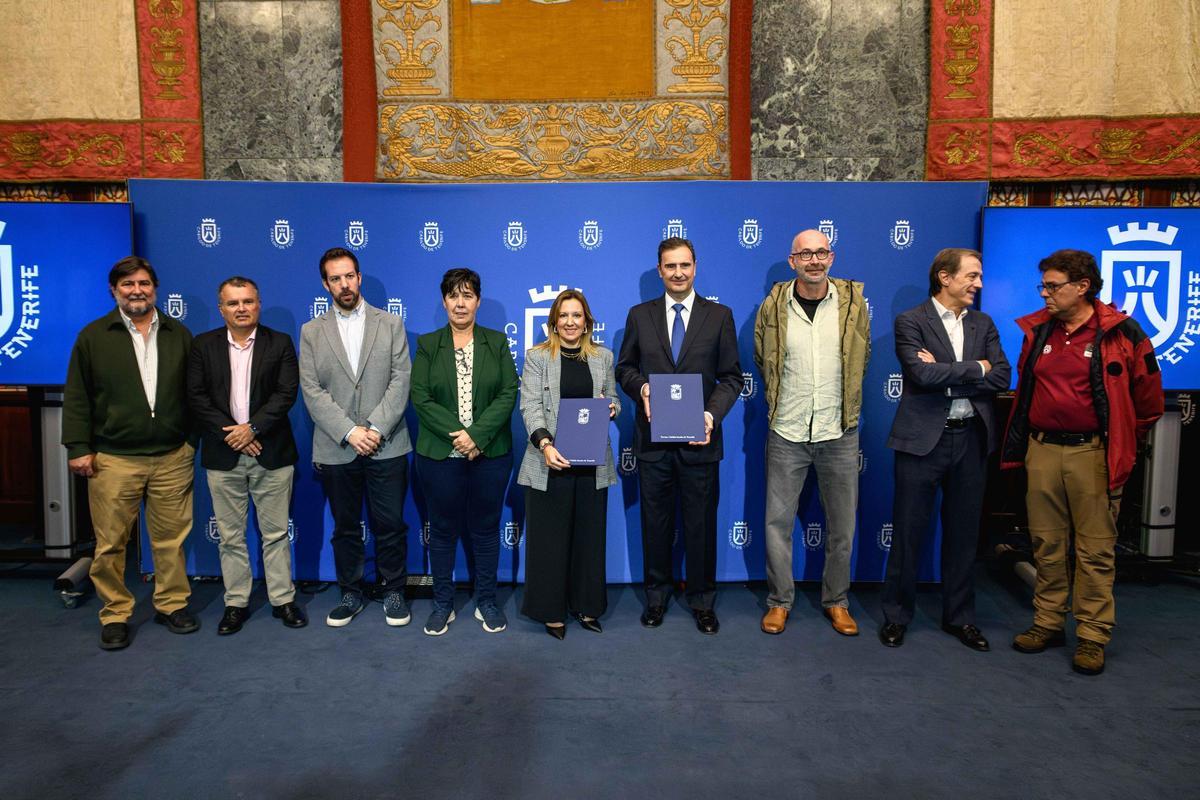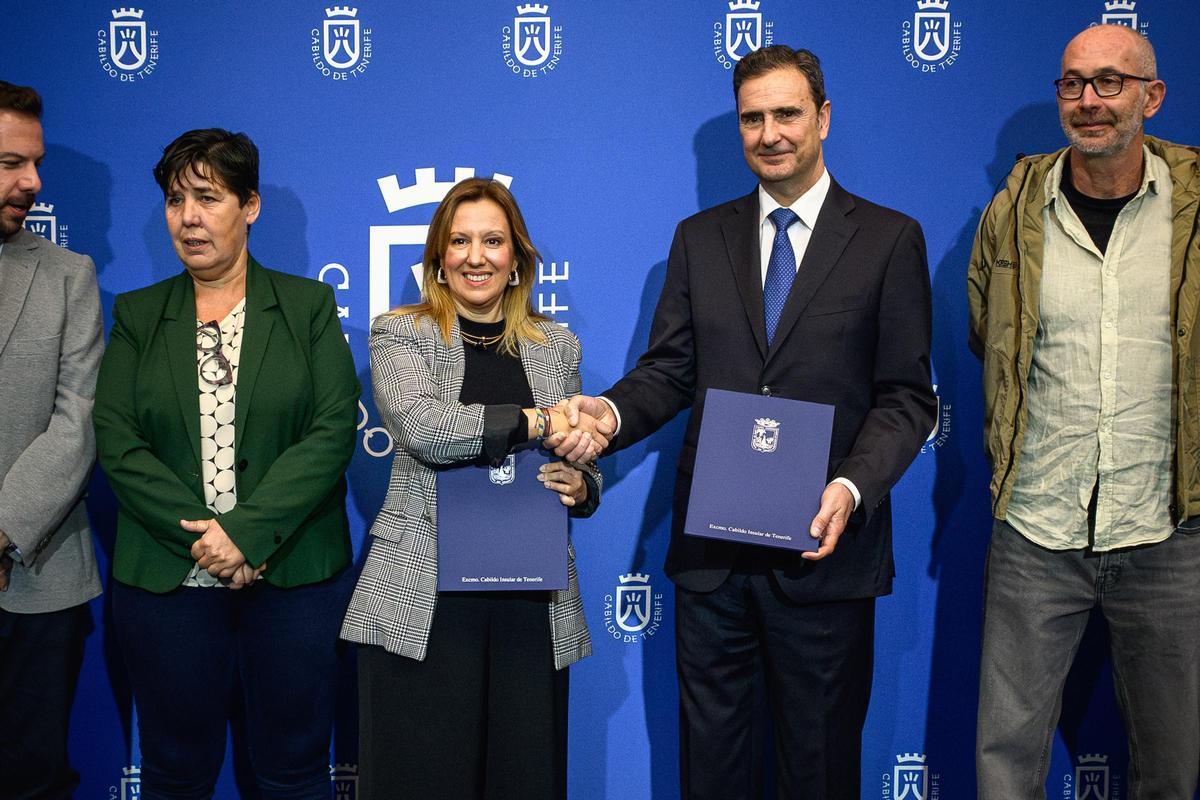The Cabildo de Tenerife, the Endesa Foundation, and the University of Valladolid have forged an institutional, commercial, and academic collaboration aimed at safeguarding the Biodiversity of the Teide National Park. This initiative specifically targets the ancient cedars located in hard-to-reach areas within the largest protected space in the Canary Islands, regarded as the island’s crowning treasure by the island’s president, Rosa Dávila. Furthermore, the research will also incorporate new data involving Carbon-14 that suggests certain specimens may predate human existence, potentially being older than those identified in 2022, such as Bárbol (1,400 years), or the patriarch tree (1,100 years) discovered in 2019. Rosa Dávila spearheaded the announcement of the agreement, alongside the Insular Counsellor of Natural Media, Blanca Pérez, the general director of the Electric Company in the Canary Islands, Pablo Casado, and the professor, biologist, and researcher from the Educational Centre of Castilla y León, José Miguel Olano.
Population
The park’s conservator, Manuel Durbán, disclosed that this extraordinary environment hosts approximately 700 natural specimens; in other words, they originated there, although in total there are around 10,000, of which 9,000 consist of very small replanted individuals. Furthermore, there is a concurrent project aimed at replanting another 15,000 cedars in the long term to partially restore the cedar forests from the indigenous era, which have been diminished by human activity along with the native herbivorous fauna, primarily goats. This explains their presence in locations that are extremely difficult to access.
Technique
The radiocarbon dating technique has confirmed the longevity of El Patriarca and the CEDRO DE MONTAÑA RAJADA, the latter’s location kept undisclosed in line with preservation guidelines. Currently, samples from other specimens have been dispatched to Poland and Salamanca for a second opinion. Olano stated: “We are eager to learn the results,” which are anticipated in approximately six months.

Group photo from the signing ceremony of the agreement between Cabildo, Endesa Foundation, and the University of Valladolid, aimed at preserving the biodiversity of Teide National Park / Ed
Agreement
The three organisations formalised an agreement to research and access these towering cedars, which typically flourish on cliff faces. Additionally, they will establish new populations of the Violeta de Guajara and the Silver Thistle. The University Foundation boasts leading experts, including Olano, who has decades of experience researching the cedars of the Canary Islands.
Legacy
Rosa Dávila emphasised that “this is a significant day for Tenerife and for the natural legacy we wish to leave for future generations through the protection of the biodiversity of our Teide National Park, a distinctive area that forms part of the heritage of all humanity.” She underscored the importance of collaboration among governmental entities, private organisations, and academia to “generate impactful projects.” She characterised the Teide environment as “a Natural Laboratory of Biodiversity, History, and Science that must be safeguarded with all available resources.”
Pioneer
Pablo Casado, the director of Endesa in the Canary Islands, expressed his immense satisfaction with this agreement, marking it as the first of its kind formalised by the Endesa Foundation in the Canary Islands. “However, we may have the opportunity to extend this initiative across the islands,” he added. Casado also took the chance to convey a message of awareness, urging both the Canarian community and the increasing number of visitors to champion the preservation of the islands’ biodiversity. He concluded: “Teide National Park is a unique enclave, and it is the responsibility of all of us to do our bit towards its optimal conservation.”
Collaboration
José Miguel Olano highlighted that the partnership between the Teide and Cambium National Parks, which he oversees, led to the identification of the Patriarch tree in 2019, which held the title of the oldest tree in the Canary Islands, at 1,100 years old, and subsequent studies revealed even older specimens beyond that, identifying Barbol as the oldest in the entire European Union, boasting an age of 1,481 years. He valued these investigations as instrumental in appreciating the heritage significance of the Teide cedars and, alongside other projects, aiding in understanding the vegetation that thrived in the park prior to human settlement. Olano, collaborating on this effort with Gabriel Sangüesa, expects to discover “even older individuals in an exploration that brings an adventurous aspect.” He clarified that “these will be the first humans to reach some of these trees, as they are situated in inaccessible cliffs requiring complex climbing techniques.”

Agreement to safeguard the biodiversity of the National Park. / Ed
Recovery
Blanca Pérez expressed her contentment regarding the agreement “that enables us to restore part of the biodiversity within the Teide National Park.” She remarked: “This exemplifies public-private collaboration benefiting the community, and we anticipate positive outcomes.”
Project
The Cédros prospecting initiative aims to reach the taller trees that grow on the most inaccessible cliffs of Teide National Park. This is a complementary effort to other projects undertaken by the Cabildo de Tenerife aimed at Restoring the ancient forests of this species that once graced the island, now within what is today the Teide National Park. In this regard, additional parallel efforts include reforestation, enhancing habitats for seed-dispersing avifauna, such as crows and capiblancos blackbirds, and performing Paleopollen studies conducted by the Universidad de La Laguna in previous years.
Information
There is evidence suggesting the possible existence of even older trees in the vicinity of Teide. Their discovery would signify an important stride in understanding the composition of past forests, as the cedars inhabiting the National Park likely stem from these ancient specimens. Additionally, they serve as a valuable resource for reconstructing climatic conditions over recent centuries, as the study of their growth rings reflects the temperature and precipitation patterns of each year, providing significant insights.
Equipment
To implement this project, a team of climbers skilled in reaching the most challenging trees and scientists renowned for their expertise in dating and analysing growth rings within Teide National Park has been assembled. The climbers will access the trees, collect samples of bark, trunk, and leaves, which will subsequently undergo analysis using scientific techniques, including Carbon-14 dating, currently recognised as the most accurate method available.
The Violeta
Concerning the restoration of the Violeta de Guajara and the Silver Thistle, this falls under the second agreement. Both species are threatened. The primary objective is to establish a new population of the recently identified Violeta de Guajara. Currently, 99% of the specimens, amounting to a few thousand, are confined to a single location at the summit of Guajara. A new population will be cultivated at the apex of the surrounding area, with approximately one hectare exhibiting similar conditions to Guajara. The actions will entail fencing off access points to prevent herbivore entry. Subsequently, at least 50 specimens will be transplanted.
The Thistle
A proposal also exists to cultivate a new population of Silver Thistle. This plant faced severe endangerment a few decades ago, with merely several hundred specimens remaining. Due to climate change impacting populations at lower altitudes, it is essential to transplant them to higher elevations. This will occur in a sector of White Mountain which combines suitable ecological conditions for thistle growth.
Subscribe to continue reading
















